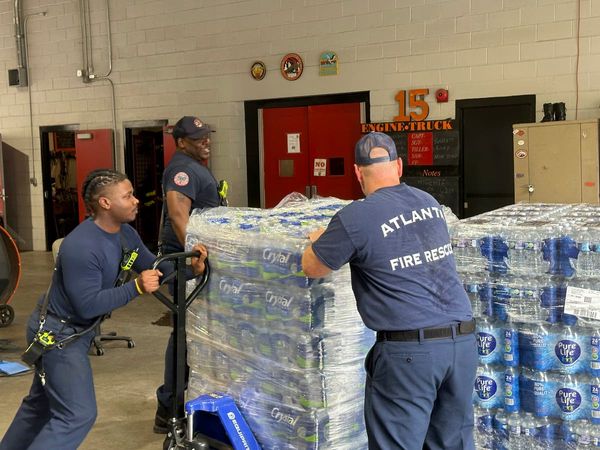DULUTH, Minn. — Minnesota and Wisconsin so far seem to be avoiding a mysterious decline in wild turkey numbers that has plagued several southern states in recent years, with populations in the north holding steady even through some tough winters.
While getting an accurate handle on a statewide turkey population is a difficult task, biologists in Minnesota and Wisconsin say that hunter harvest data and other anecdotal reports show turkey numbers in both states holding their own and that spring turkey hunters should see good numbers of birds when they go afield starting next week.
Even if there's still snow on the ground.
Last year, 54,491 hunters went afield in Minnesota and bagged 12,309 tom turkeys, down a bit from records set in 2020 during the pandemic-fueled rush to get outdoors, but still more than years leading up to the pandemic.
In Wisconsin, 219,714 permits were issued (hunters can get bonus tags where they are available) and 38,926 birds were registered. That"s down some from the peak in both categories in 2009, but consistent with a mostly stable harvest for the past decade.
"Nothing we're seeing indicates any big change in our turkey population," said Tim Lyons, upland game specialist for the Minnesota Department of Natural Resources.
Taylor Finger, upland game bird specialist for the Wisconsin Department of Natural Resources, said Wisconsin's turkey restoration story is classic of a reintroduced species. The birds exploded in number and range across the state from the 1980s-2009, filling in suitable habitat, then the number leveled off, as did the annual harvest.
"They reached their carrying capacity in the state and have leveled off at what's been a pretty stable level," Finger noted.
Meanwhile, states like Kansas, Missouri, Florida, Mississippi and others have seen dramatic declines in turkey numbers in some areas after a half century of growth or stability. Scientists are focusing on poor survival of turkey chicks, called poults, as a primary reason many southern populations are dropping. With fewer new turkeys coming up through the ranks, and old turkeys getting shot, the population is not sustainable in some areas.
Several culprits have been named, including predators, too many turkeys killed by hunters, declining habitat and climate change — a trend toward much heavier rainfall events that are drowning young chicks out before they are old enough to fend for themselves.
In Tennessee, the number of poults per hen surveyed in late summer dropped from a high of seven in 1984 to just 1.4 by 2020, according to the Tennessee Wildlife Resources Agency.
"I think it's probably an all of the above situation," said Finger. "There's no smoking gun."
In places like Florida, rapid development has destroyed prime turkey habitat. Changing logging practices, farming practices and liberal bag limits — some states have allowed hunters to shoot multiple birds each season — are also likely culprits, as are skunks, raccoons and other nest-raiding predators.
Turkeys shot by hunters "is the number one cause of adult turkey mortality, and I think that a lot of those states had really liberal bag limits for a long time. You can't discount the impact hunters have on the population in those cases," Finger said.
Tennessee recently dropped its season limit from four to three birds. Minnesota has always allowed only one bird per season. In Wisconsin, hunters can purchase additional tags where they are available, and shoot more birds, but Finger said more than 90% of hunters do not shoot more than one bird.
Meanwhile, poults are most vulnerable in early summer when they can't regulate their body temperatures. If heavy rain hits at the wrong time, and data shows a clear trend toward more downpours, those poults can't survive.
There's also a sense that allowing hunters in the field during most of the breeding season is disrupting tom turkey gobbling, and thus disrupting the mating cycle, leading to fewer hens being bred. Some states have recently delayed their turkey seasons to give the birds more time to mate before hunting starts each spring.
In Minnesota, biologists last year started a new project to compute hunter effort and hunter harvest in the two most popular turkey zones, 501 and 507 — a diagonal swath of the state's hardwood forests from southeast to northwest — to determine a rough population to use as a baseline to mark any future trends. It's the first time Minnesota would have an actual population estimate.
"We don't think we have major issues with turkeys right now. But we also don't have a lot of data that would help us see trends other than hunter harvest," Lyons said.
Wisconsin is blessed with perhaps a perfect mix of habitat for turkeys, areas of hardwood forest for hiding and nesting interspersed with agriculture fields that provide plenty of food. Minnesota certainly has good habitat, but also has vast areas of open, treeless prairie in the southwest, and thick conifer forest in the northeast, that aren't prime for turkeys.
Still, turkeys have spread across Minnesota — for years transplanted by the DNR and National Wild Turkey Federation but in recent decades exploring and expanding on their own, all the way north to the Canadian border.
Lyons says Minnesota can't take its prime turkey habitat for granted. Studies show a trend toward more rainfall may be drowning out oak trees in some areas, often replaced with ash, honeysuckle and invasive buckthorn that don't produce good food like acorns
"We haven't seen a problem with disease. We haven't heard of any cases of avian influenza in turkeys, for example," Lyons said. "But, looking out 50 years, I'd say that hardwood habitat is probably going to be the key for Minnesota's turkey future."
Finger said turkeys are doing so well up north that the DNR added 600 permits this year for Zone 6, which covers nearly all of Northwestern Wisconsin including Douglas County, by 600. Other areas of the state saw the same number of permits as last year, with 246,543 tags available this spring.
For turkeys in the Northland, the issue isn't cold, it's food. Experiments putting live turkeys in a cold chamber found they can withstand even long periods of below-zero temperatures.
Even this winter's deep snow probably won't hit turkeys too hard in Northeastern Minnesota, said Chis Balzer, DNR wildlife manager for the Cloquet/Duluth area, if the birds can find food.
"Turkeys are definitely a little tougher than we thought in the past," Balzer noted. "I am sure a few succumb to winters like this. But turkeys made it through the winter of 2013-14 OK. We probably lost a few that winter, and numbers may be down a little this spring, but there will still be turkeys around."
Turkeys, often in large flocks, seem to move significant distances to find food in the winter, Balzer said, then move back to fill in their breeding and summer range.
"Finding food in the woods right now is pretty tough for them. But I think most of them find food sources related to people such as cattle feeding operations, bird feeders or deer feeders," Blazer added. "They are able to handle cold weather just fine as long as they can find food. Many areas that have turkeys in the spring, summer and fall are devoid of turkeys in the winter, but they show back up each spring.
In Wisconsin, the DNR has incorporated a new app and asking hunters and others to report how many turkey broods they see each August and how many poults are in that brood. It's citizen science that could help determine any trends in recruitment, or how many new birds are replacing adults that are harvested.
August is considered a key time for turkey poults, the point they can be expected to make it into adulthood. The survey period is from Aug. 1-31. You can help by recording and reporting your observations of broods for grouse as well as turkeys.
You can find out more at
dnr.wisconsin.gov/topic/WildlifeHabitat/GameBirdBroodObservations
— — —
In Minnesota, hunters have the leisurely option of picking any of six separate seasons that start April 12. You can purchase a license right up to the day you start hunting and hunt anywhere you want in the state, limited only to the time period you choose.
The DNR asks hunters to list what zone they are likely to hunt in but, other than a few wildlife management areas, hunters can hunt wherever they want in the state.
Anyone who doesn't fill their tag in the first five seasons can hunt again in Season F, which is the only two-week season but is generally considered to fall after most turkey mating activity is over.
Minnesota 2023 spring turkey seasons:
— Archery season — April 12-May 31
— Youth season — April 12-May 31
— Firearms Season A — April 12-18
— Firearms Season B — April 19-25
— Firearms Season C — April 26-May 2
— Firearms Season D — May 3-9
— Firearms Season E — May 10-16
— Firearms Season F — May 17-31
Minnesota wild turkey licenses may be purchased online, by phone at 888-665-4236 or in person wherever hunting and fishing licenses are sold. Adult resident licenses are $8 plus fees; nonresidents are $96. Both include the state turkey stamp.
Rules include using only shotguns or muzzleloader shotguns at least .410 or larger and no larger than 10 gauge. Only fine shot size No. 4 and smaller diameter (sizes 4, 5, 6, 7 1/2 , 8, etc.) may be used. Red dot scopes and rangefinders are legal.
For more information, go to
dnr.state.mn.us/hunting/turkey/index.html
— — —
The Badger state's 2023 six, weeklong, Wednesday-Tuesday turkey seasons begin April 19 and run through May 30. But most of the permits for most areas of the state were gobbled up over the winter in a lottery or in an open sale held last month.
The exception is in southern Wisconsin where thousands of unclaimed permits are available for later seasons in southern zones. More than 30,000 permits were still available at last check for seasons E and F, mostly in zones 1 and 3.
Wisconsin turkey seasons for 2023:
— Youth only season — April 15-16
— Firearms Season A — April 19-25
— Firearms Season B — April 26-May 2
— Firearms Season C — May 3-9
— Firearms Season D — May 10-16
— Firearms Season E — May 17-23
— Firearms Season F — May 24-30
It costs $15 to purchase a spring "bonus" turkey authorization and acquire one of the still-available permits. That's in addition to your turkey hunting license ($15 for residents, $60 for nonresidents) and turkey and stamp for $5.25.
For more information, go to
dnr.wisconsin.gov/permits/springturkey.html
———
Wild turkeys were occasionally reported by early pioneers arriving in what is now Minnesota, but the bird had disappeared from the state by 1900. Settlers realized turkeys were easy targets each night when the birds roosted in trees.
Several efforts were tried to restock turkeys in southern Minnesota over the years, but the first successful transplant happened in 1973. The state traded 85 ruffed grouse to Missouri for 29 wild turkeys released in Houston County near the Iowa border. All of the state's turkeys come from that transplant, with birds captured and released around the state through the 1990s.
The turkeys did better than expected just about everywhere they were released, and then expanded their range on their own.
In 1978, the state's first turkey hunting season, a few hundred hunters registered 94 turkeys. Last year, Minnesota issued just over 54,000 turkey permits during the spring season and hunters registered more than 12,000 birds.
According to state natural resource agencies, the state's harvesting the most wild turkeys in 2021 were:
— Alabama — 57,567
— Tennessee — 53,669
— Michigan — 41,777
— Wisconsin — 37,266







